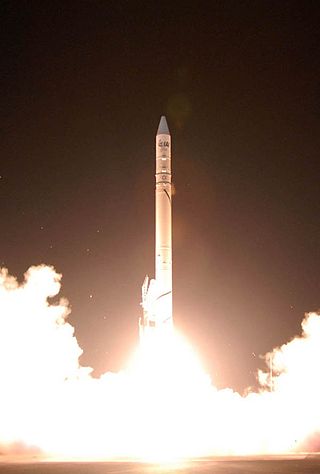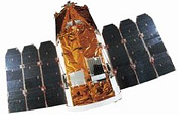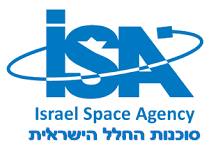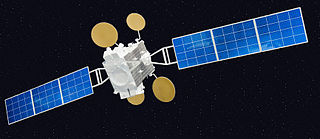Related Research Articles

Israel Aerospace Industries or IAI (תע"א) is Israel's major aerospace and aviation manufacturer, producing aerial and astronautic systems for both military and civilian usage. It has 15,000 employees as of 2018. IAI is completely state-owned by the government of Israel.

Ofeq, also spelled Offek or Ofek is the designation of a series of Israeli reconnaissance satellites first launched in 1988. Most Ofeq satellites have been carried on top of Shavit 2 launch vehicles from Palmachim Airbase in Israel, on the Mediterranean coast. The low Earth orbit satellites complete one Earth orbit every 90 minutes. The satellite launches made Israel the eighth nation to gain an indigenous launch capability. Both the satellites and the launchers were designed and manufactured by Israel Aerospace Industries (IAI) with Elbit Systems' El-Op division supplying the optical payload.

Earth Resources Observation Satellite (EROS) is a series of Israeli commercial Earth observation satellites, designed and manufactured by Israel Aircraft Industries (IAI), with optical payload supplied by El-Op. The satellites are owned and operated by ImageSat International N.V. (ISI), a company founded in 1997, as a Joint venture between IAI, El-Op and Core Software Technology (CST). EROS A was launched on December 5, 2000 and EROS B on April 25, 2006.

The Israel Space Agency is a governmental body, a part of Israel's Ministry of Science and Technology, that coordinates all Israeli space research programs with scientific and commercial goals.

AMOS is a series of Israeli communications satellites operated by Israel-based Spacecom. All AMOS satellites were developed by Israel Aerospace Industries (IAI) using the AMOS bus satellite bus, except for AMOS-5 which was developed by ISS Reshetnev using the Ekspress bus satellite bus, and AMOS-17 which was developed by Boeing on its BSS-702.
AsiaSat 2 was a Hong Kong communications satellite, which was owned, and was initially operated, by the Hong Kong based Asia Satellite Telecommunications Company. It was positioned in geostationary orbit at a longitude of 17° East of the Greenwich Meridian, on lease to Spacecom. It spent most of its operational life at 100.5° East, from where it was used to provide fixed satellite services, including broadcasting, audio and data transmission, to Asia and the Pacific Ocean.
Spacecom, or Space Communication, is an Israeli communications satellite operator in the Middle East, European Union and North America headquartered in the city of Ramat Gan, Israel. Spacecom operates two satellites at orbital position 4° West – AMOS-3 and AMOS-7, one satellite at orbital position 65° East – AMOS-4, and one satellite at orbital position 17° East – AMOS-5.
AMOS-1, then INTELSAT 24, is a commercial communications satellite which was operated by Spacecom as AMOS-1, for Affordable Modular Optimized Satellite and formed part of the AMOS series of satellites. It was the first Israeli civilian communications satellite, and was initially positioned at 4° West longitude in geostationary orbit. Then in September 2011, it was moved to 31° East.
AMOS-2 is an Israeli commercial second generation communication satellite, part of the AMOS series of satellites. The satellite was positioned at 4° West longitude in the geostationary orbit. Transmission and communication services given by this satellite include: direct distribution of television and radio translations to communication centers, distribution of internet services, data transmissions to communication networks. The new satellite, like its predecessor, will be positioned 36,000 kilometers above the Earth, and it will lie close to AMOS-1, so that the two can share a single space antenna.

Ofeq-7 is part of the Ofeq family of Earth observation satellites designed and built by Israel Aerospace Industries (IAI) for the Israel Ministry of Defense.
AMOS-3, also known as AMOS-60, is an Israeli communications satellite operated by Spacecom Satellite Communications.
Ofeq-9, also known as Ofek 9, is part of the Ofeq family of reconnaissance satellites designed and built by Israel Aerospace Industries (IAI) for the Israeli Ministry of Defense.
The Earth Remote Observation System-A was part of the EROS family of Israeli commercial Earth observation satellites, designed and manufactured by Israel Aircraft Industries (IAI). This was the first satellite in the series. The satellite was owned and operated by ImageSat International, ImageSat International N.V. (ISI) headquartered at Limassol, Cyprus, and incorporated in the Netherlands Antilles, Cayman Islands.

The Earth Remote Observation System-B (EROS-B) is the second satellite launched in a series of the EROS family of Israeli commercial Earth observation satellites, designed and manufactured by Israel Aircraft Industries (IAI). It is owned and operated by ImageSat International N.V. (ISI), in the Netherlands Antilles, Cayman Islands, with offices in Limassol, Cyprus, and in Tel Aviv, Israel.

AMOS-6 was an Israeli communications satellite, one of the Spacecom AMOS series, that was built by Israel Aerospace Industries (IAI), a defense and aerospace company.
AMOS-4 is an Israeli commercial communications satellite, operated by Spacecom Satellite Communications, Tel Aviv-based, part of the AMOS series of satellites.

Amos-5 was an Israeli commercial communications satellite, part of the AMOS series of satellites. It was developed and built for Spacecom by Information Satellite Systems Reshetnev, the largest Russian satellite producer, at a cost of US$157 million. The satellite was positioned at the 17° East longitude in the geostationary orbit. It was launched on 11 December 2011, 11:17:00 UTC from Baikonur Cosmodrome, Kazakhstan, atop a Proton-M / Briz-M launch vehicle. It provided coverage over the continent of Africa, as well as Europe and the Middle East.

AsiaSat 8 then AMOS-7 is a Hong Kong-turned-Israeli geostationary communications satellite which is operated by the Asia Satellite Telecommunications Company (Asiasat).
AMOS-17 is an Israeli commercial communications satellite, part of the AMOS series of satellites.
AMOS-8 is a planned Israeli communications satellite, one of the Spacecom AMOS series, that is built by Israel Aerospace Industries (IAI), a defense and aerospace company, for replaced AMOS-6 and AMOS-7
References
- ↑ "IAI to launch new 5-ton AMOS satellite". Space Daily. 16 July 2012. Retrieved 26 July 2016.
- 1 2 "IAI: AMOS Bus". Gunter's Space Page. 9 April 2016. Retrieved 26 July 2016.
- 1 2 "AMOS1 Communications Satellite". Israel Aerospace Industries. 12 October 2015. Retrieved 26 July 2016.
- 1 2 "AMOS2 Communications Satellite". Israel Aerospace Industries. 12 October 2015. Retrieved 26 July 2016.
- 1 2 "AMOS3 Communications Satellite". Israel Aerospace Industries. 12 October 2015. Retrieved 26 July 2016.
- ↑ "IAI/MBT Division Space Technologies". Israel Aerospace Industries. 18 June 2001. Retrieved 26 July 2016.
- 1 2 "Israel Aerospace Industries (IAI) has successfully launched Spacecom's AMOS-4". Israel Aerospace Industries. 31 August 2013. Retrieved 26 July 2016.
- 1 2 "AMOS 4". Gunter's Space Page. 17 April 2016. Retrieved 26 July 2016.
- 1 2 "AMOS4 Communications Satellite". Israel Aerospace Industries. 12 October 2015. Retrieved 26 July 2016.
- 1 2 "AMOS 6". Gunter's Space Page. 17 April 2016. Retrieved 26 July 2016.
- 1 2 de Selding, Peter B. (15 October 2015). "Israel Aerospace Industries Sharpens its Satellite Export Focus". SpaceNews. Retrieved 26 July 2016.
- ↑ "IAI is developing the AMOS-E Satellite". Israel Aerospace Industries. 12 October 2015. Retrieved 26 July 2016.
- ↑ "AMOS 1 → Intelsat 24". Gunter's Space Page. 17 April 2016. Retrieved 26 July 2016.
- ↑ "AMOS 2". Gunter's Space Page. 17 April 2016. Retrieved 26 July 2016.
- ↑ "AMOS 3 (AMOS 60)". Gunter's Space Page. 17 April 2016. Retrieved 26 July 2016.